If you’re not familiar with the various types of oscilloscopes available, navigating the world of analog versus digital can seem like entering a foreign country. It doesn’t have to be so confusing, though!
With increasingly more powerful tools and machines being released every day, it is important for anyone working on electrical devices or circuitry to understand what each type has to offer.
In this article we will explore the differences between an analogue and a digital oscilloscope as well as their capabilities.
By understanding which option is best suited to your needs, you can make sure that whatever project you are attempting is done right — accurately and efficiently!
What is an Oscilloscope?
It is more accurate than other tools like metres and voltmeters. Oscilloscopes are used in electronics, communication, and engineering.
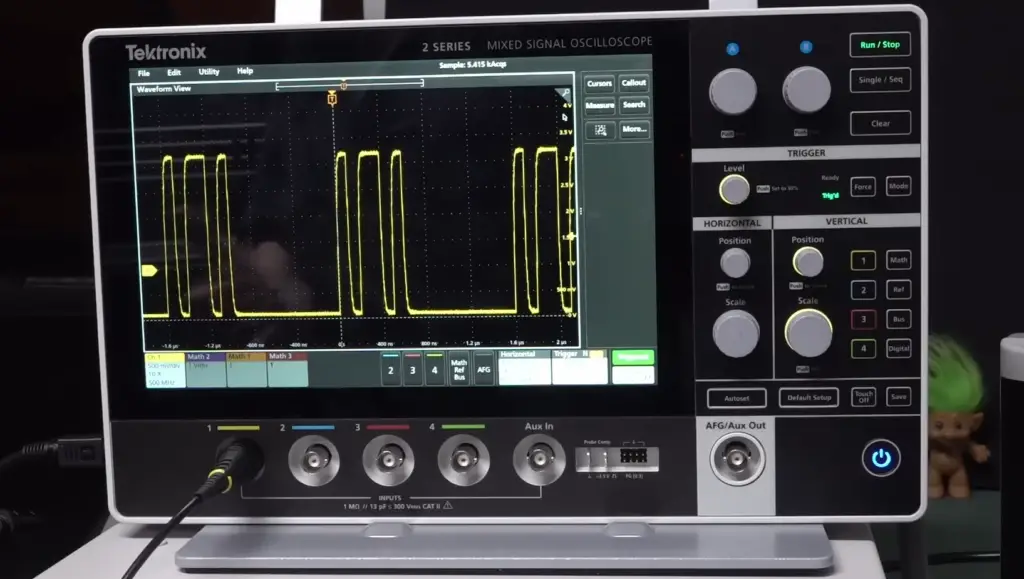
Analog Oscilloscopes
An analog oscilloscope is the oldest type of the two. It uses an actual physical needle to trace a signal which makes this type of oscilloscope easier to read than digital ones.
Analog scopes are cheaper and simpler than digital models, but not as precise or accurate. They also have limited memory capabilities and can be difficult to use for complex measurements.
Digital Oscilloscopes
A digital oscilloscope is a newer type of oscilloscope. It takes data and turns it into a picture on the screen.
Digital models are more exact than analog ones, so they can measure signals better and show more details. You can also save your measurements for later.
Digital oscilloscopes are also capable of more complex measurements than analog models and can be used for a variety of tasks such as measuring frequency, amplitude, or even generating graphs to plot data over time.
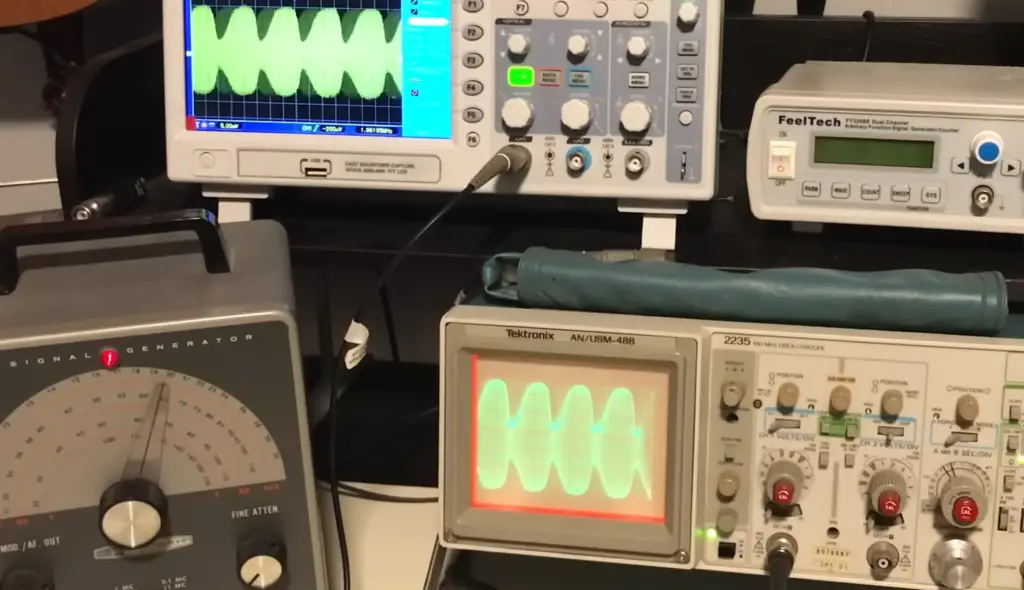
They also have larger memory capabilities which allow you to store more information, making them ideal for long-term projects. [1]
Types of Digital Oscilloscopes
Mixed-Signal and Mixed-Domain Oscilloscopes
Mixed-signal and mixed-domain oscilloscopes can measure both analog and digital signals. They offer the ability to view multiple signals in one display and make it easier to debug complex electronic systems.
These oscilloscopes are also capable of performing a variety of advanced measurements, including eye pattern analysis, pulse response characterization, jitter analysis, and more.

Digital Sampling Oscilloscopes
Digital Sampling oscilloscopes are the most common type of digital scopes. They take the incoming signals and turn them into digital numbers so they can be displayed on a screen.
These scopes are more accurate than regular ones. Plus, they have lots of memory and extra features like special measurements and maths tools.
Key Differences Between an Analog and Digital Oscilloscopes
Differences in Operation
The main difference between analog and digital oscilloscopes is how they interpret incoming signals.
Analog scopes use a physical needle to draw the signal on a screen, while digital scopes turn the signal into numbers and display it as a graph. This makes digital scopes more accurate than analog ones and better for complex measurements.
Differences in Specifications
Digital and analog oscilloscopes are different. Digital scopes usually have more memory, better resolution, faster speeds and other features that make them better than analog ones.
They can also do things like eye pattern analysis and jitter analysis which is not possible with analog scopes.
Sample/Sampling Rate
Analog scopes have a limited sample rate as they draw the signal onto the screen. Digital scopes can sample signals much faster and more accurately, making them better for complex measurements.
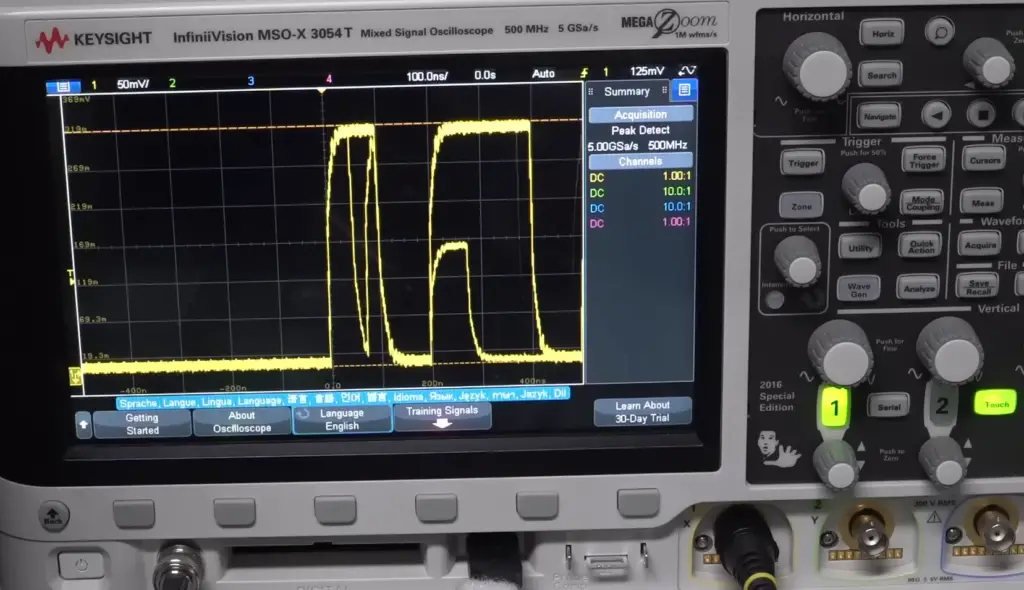
Price Range
Analog oscilloscopes are usually cheaper than digital ones, so if you need something simple or just to get started, an analog scope might be the best choice.
However, digital scopes are more versatile and can do things that analog scopes cannot, so they tend to cost more.
Memory Depth/Size
Digital oscilloscopes usually have more memory than analog ones, so they can store more information. This is especially useful for long-term projects or complex measurements.
Input Ranges and Probes
Most analog scopes are limited to a single probe, while digital scopes can have multiple probes for different measurements.
Digital scopes also usually have a wider range of input ranges, making them better suited for complex measurements.
Resolution
Digital scopes usually have higher resolution than analog scopes. This means they can show more detail and make more accurate measurements.
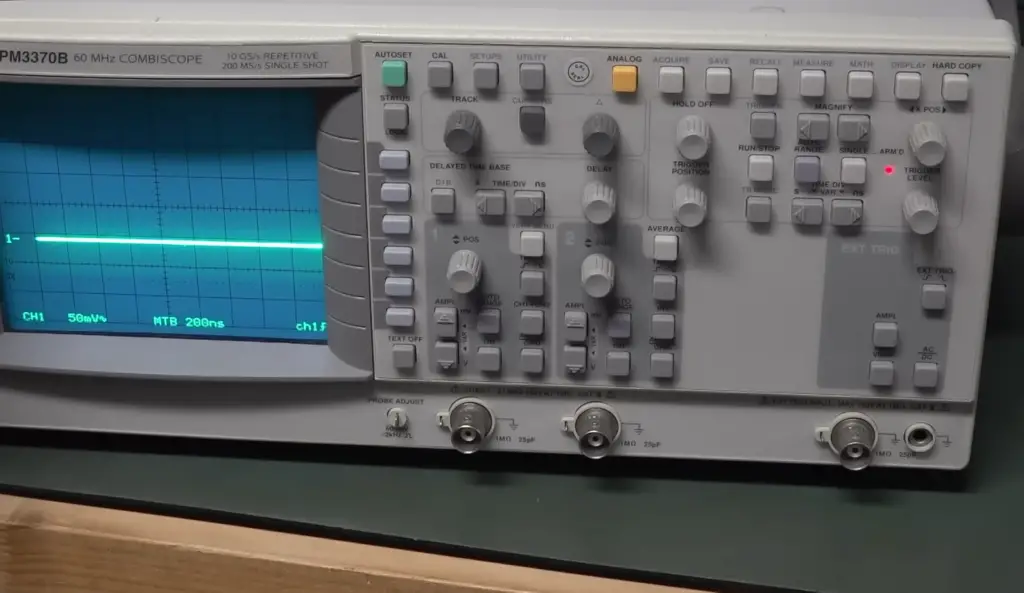
Digital oscilloscopes are great for complex tasks and long-term projects. They have more memory, better resolution, higher accuracy, and can measure a wider range of signals. But if you just need something basic, an analog scope is better.
Trigger
Digital scopes usually offer more triggering modes than analog ones. Triggering is important for accurately measuring signals and digital scopes can do this with more accuracy than analog scopes. [2]
Advanced Measurement Functions
Digital oscilloscopes have a variety of advanced features that make them better suited for complex tasks. They can measure frequency, phase, rise and fall times, pulse widths, duty cycles, jitter, eye patterns, and more. Analog scopes can’t do these measurements.
Overall, digital oscilloscopes offer a lot of advantages over analog ones. They are more accurate and have more features that make them better for complex measurements. If you need something for more than just basic tasks, a digital scope is the way to go.
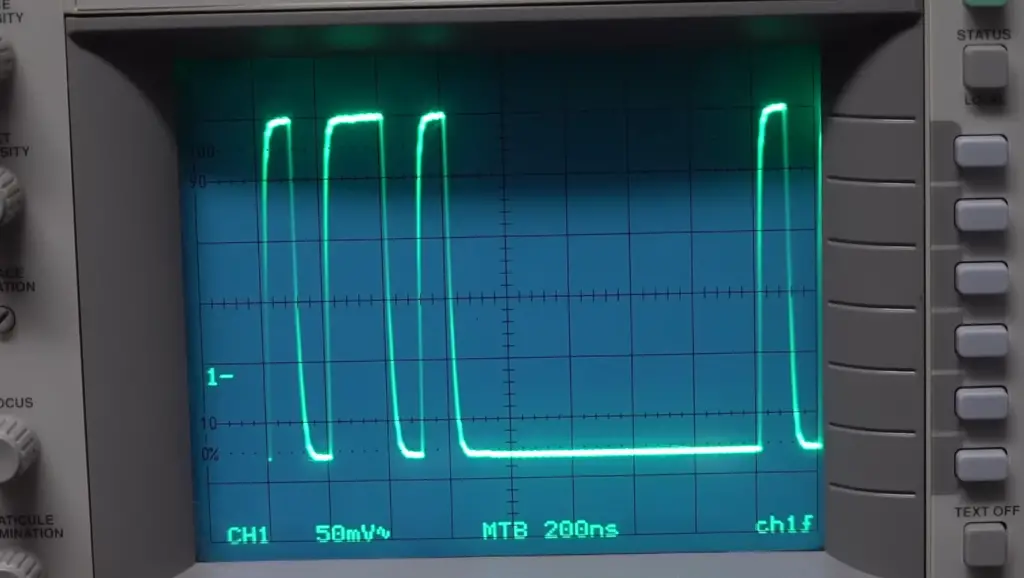
FAQ
Which is better: digital or analog oscilloscope?
Digital oscilloscopes offer more accuracy and features than analog ones, so they are better for complex tasks.
They also offer more memory, faster speeds, wider input ranges, and a variety of advanced measurements. If you need something for basic tasks, an analog scope might be the best choice.
What is the difference between a digital and an analog oscilloscope?
The main difference between digital and analog oscilloscopes is how they interpret incoming signals. Analog scopes use a physical needle to draw the signal on a screen, while digital scopes turn the signal into numbers and display it as a graph.
Digital scopes usually have more memory, better resolution, faster speeds and other features that make them better than analog ones. They can also do things like eye pattern analysis and jitter analysis which is not possible with analog scopes.
Are digital oscilloscopes more expensive than analog ones?
Digital oscilloscopes usually cost more than analog ones, but they offer a lot of features that can’t be found in analog scopes.
Which oscilloscope should I buy?
It depends on your needs and budget. If you just need something basic, an analog scope might be the best choice.
But if you need something that can do more complex measurements, a digital scope is probably the way to go. Consider your needs and budget when making your decision.
What is the advantage of a digital oscilloscope over an analog oscilloscope?
Digital oscilloscopes offer more accuracy, better resolution, wider input ranges, more triggering modes, and a variety of advanced measurement functions.
They also have more memory, meaning they can store more data for long-term projects or complex measurements.
What is an analog oscilloscope?
An analog oscilloscope is a device used to measure and display electrical signals. It uses a physical needle to draw the signal on a screen, so it can be read by the user.
Analog scopes are often used for basic tasks, but they cannot do more complex measurements like frequency analysis or jitter analysis.
What are the disadvantages of digital oscilloscopes?
Digital oscilloscopes are usually much more expensive than analog ones, and they can be complex to set up and operate. They also require more frequent calibration, so that the readings obtained are accurate.
Additionally, digital scopes have a limited input range and often require specialised probes or adapters for measuring different signals.
Can I use a digital oscilloscope for basic tasks?
Yes, you can use a digital oscilloscope for basic tasks. However, an analog scope is usually the better choice if all you need to do is measure voltage or frequency.
Digital scopes are better suited for more complex measurements and offer features that cannot be found in analog scopes.
What is the main advantage of digital over analog?
The main advantage of digital oscilloscopes over analog ones is accuracy. Digital scopes are more accurate and can provide more detailed measurements than analog scopes. They also offer features like eye pattern analysis and jitter analysis which cannot be done with an analog scope.
Additionally, digital scopes have higher memory capacity and faster speeds which make them better for long-term projects or complex measurements.
What are the advantages of using an analog oscilloscope?
Analog scopes offer basic functions such as voltage and frequency measurement, which is often all that is needed for simple tasks. They also tend to be cheaper than digital scopes and easier to set up and use.
Additionally, they have a wider input range, meaning they can measure different types of signals without an adapter or specialised probe.
Is it better to buy a digital oscilloscope or an analog one?
It depends on your needs and budget. If you just need something basic, an analog scope might be the best choice.
But if you need something that can do more complex measurements, a digital scope is probably the way to go. Consider your needs and budget when making your decision.
What kind of measurements can a digital oscilloscope make?
A digital oscilloscope can measure voltage, current, frequency, amplitude, and phase.
It can also do more complex measurements such as eye pattern analysis and jitter analysis. Additionally, it can store data for long-term projects or complex measurements.
What is the difference between sampling rate and bandwidth?
The sampling rate is how often the signal is measured by the oscilloscope in a given period of time, usually expressed in samples per second.
The bandwidth is the maximum frequency that can be accurately measured by the oscilloscope, usually expressed in megahertz (MHz). The higher the sampling rate and bandwidth are, the more accurate and detailed the measurements will be.
Are there any other differences between analog and digital oscilloscopes?
Yes, there are a few more differences between analog and digital oscilloscopes. Analog scopes tend to have simpler user interfaces, but they can only measure basic signals like voltage and frequency.
Digital scopes are usually more accurate and can make more complex measurements, but they can be more expensive and require more frequent calibration. Additionally, digital scopes have a limited input range and often require specialised probes or adapters for measuring different signals.
What is the best oscilloscope for my application?
The best oscilloscope for your application depends on your needs and budget. Consider the features that are important to you and make sure you get an oscilloscope with a sampling rate and bandwidth that meets your measuring requirements.
Digital scopes tend to be more accurate, but they can also be more expensive and complex to use. Analog scopes may be easier to set up and less expensive, but they only offer basic features. Ultimately, it’s best to choose an oscilloscope that meets your needs and budget.
How do I know if my oscilloscope is working properly?
To make sure your oscilloscope is performing as expected, you can check the display and make sure that it’s displaying signals accurately. You can also use test probes to verify that the measurements are correct.
If you have a digital scope, you can use software-based tests such as eye pattern analysis or jitter analysis to make sure that the measurements are accurate.
Additionally, you can calibrate your oscilloscope on a regular basis to ensure accuracy and reliability.
How can I learn more about oscilloscopes?
Learning more about oscilloscopes doesn’t have to be complicated. There are many educational resources available online, such as blogs, forums, and tutorials.
Additionally, there are a number of books that provide an in-depth look at how these devices work and how they can be used for different applications. With a bit of research, you can gain a better understanding of oscilloscopes and how they work.
How often should I calibrate my oscilloscope?
It depends on the type of scope you have and how often you use it. If you use your scope every day, then it’s probably a good idea to calibrate it once a month or so.
However, if you only use your scope periodically, then calibration may not be necessary as often. Ultimately, it’s best to check the manufacturer’s instructions to determine the recommended calibration frequency.
Why should I invest in a quality oscilloscope?
Investing in a quality oscilloscope can help you get more accurate measurements and better results for your projects. Quality scopes are usually more precise and have higher sampling rates and bandwidths, allowing for more detailed measurements.
Additionally, they often come with advanced features like software-based tests that can make complex measurements easier.
Quality scopes also tend to be more reliable and require less frequent calibration, so they’re a better long-term investment.
Why is it important to use the right probes for my oscilloscope?
Using the right probes can help you get accurate and reliable measurements from your oscilloscope. Different types of signals require different types of probes, so make sure you use the appropriate probe for your application.
Additionally, some scopes may require special adapters or cables in order to measure certain signals. It’s important to use the right probes and adapters in order to get accurate measurements from your oscilloscope.
Does an oscilloscope have any safety considerations?
Yes, it’s important to use caution when handling and operating an oscilloscope.
Additionally, you should use insulated gloves when handling exposed parts of the scope as some parts may carry dangerous voltages. Finally, it’s best to avoid touching the probe tips when they’re connected to a live circuit as they can carry high-voltage signals.
Do I need to use a calibration kit with my oscilloscope?
It depends on the type of scope you have. Many digital scopes come with built-in calibrations, so you may not need to use a separate calibration kit.
However, some analog scopes require external calibration kits in order to ensure accuracy and reliability. It’s best to check the manufacturer’s instructions to determine if your scope requires a calibration kit.
Does an oscilloscope require regular maintenance?
Yes, it’s important to keep your oscilloscope clean and in good working condition. You should periodically check for any signs of wear or damage and make sure that all connections are secure.
Additionally, you may need to replace the probe tips over time as they can become worn down from use. Finally, make sure to keep the oscilloscope dust-free to ensure accuracy and reliability.
Does an oscilloscope need to be stored in a specific way?
Yes, it’s important to store your oscilloscope properly. To keep the scope in good condition and ensure accuracy, it should be stored in a dry, dust-free environment at room temperature.
Additionally, you may want to store the probe tips separately from the body of the scope in order to avoid any damage. Finally, it’s a good idea to keep the manual and any other documentation with the scope in case you ever need to refer to it.
Do I need to use a fan or heatsink with my oscilloscope?
It depends on the type of scope you have. Some scopes generate a lot of heat and require active cooling, such as a fan or heatsink. If your scope generates a significant amount of heat, make sure to use appropriate fans or heatsinks in order to avoid any damage.
Additionally, some scopes may require additional cooling in order to maintain accuracy and reliability. It’s best to check the manufacturer’s instructions to determine if your scope requires any active cooling measures.
Does an oscilloscope need to be recalibrated regularly?
It depends on the type of scope you have. Digital scopes often come with built-in calibrations, so they don’t need to be recalibrated as often. However, analog scopes may require periodic calibration in order to maintain accuracy and reliability.
Additionally, some older scopes may need to be recalibrated more often than newer models. It’s best to check the manufacturer’s instructions to determine if your scope needs to be calibrated regularly.
What other accessories do I need for my oscilloscope?
In addition to probes, adapters and cables, you may also need additional accessories in order to get the most out of your oscilloscope. Some accessories that may be useful include a power supply, signal generators and logic analyzers. Additionally, you may need calibration kits and other tools for specific tasks. It’s best to check the manufacturer’s instructions to determine what additional accessories you might need for your scope.
Which type of oscilloscope is best for my application?
The type of oscilloscope you need depends on the specific application. Digital scopes are generally more accurate and reliable, while analog scopes offer more flexibility and control.
Additionally, some applications may require certain features that only certain types of scopes can provide. It’s best to consult with an expert or do your own research to determine which type of scope is best for your application.
Can I use an oscilloscope for troubleshooting electronic circuits?
Yes, an oscilloscope can be used for troubleshooting electronic circuits. Oscilloscopes allow you to visualise the signals generated by a circuit, which can help you identify issues such as shorts or high resistance.
Additionally, some scopes even allow you to measure voltage and current in order to perform detailed analysis. It’s best to check the manufacturer’s instructions to determine if your scope is suitable for troubleshooting electronic circuits.
Do I need special software to use an oscilloscope?
It depends on the type of scope you have. Some digital scopes require special software in order to access advanced features and settings, while other scopes can be used without any additional software.
Additionally, some scopes may require specific drivers or other software in order to work properly. It’s best to check the manufacturer’s instructions to determine if your scope requires any special software.
What safety precautions should I take when using an oscilloscope?
Always follow the manufacturer’s instructions when using your oscilloscope. Some scopes may require special safety precautions, such as wearing eye protection or avoiding contact with certain components.
Finally, always ensure that the voltage selector switch is set to the correct voltage before powering up your scope.
Useful Video: Analog VS Digital Scopes for Glitch Captue
Conclusion
Technology is changing quickly. Digital oscilloscopes will replace analog oscilloscopes soon. Professionals and hobbyists should know the differences between the two types so they can make the best choice for their needs.
Analog oscilloscopes have steady waveforms and many features. Digital oscilloscopes display a lot of different waveforms on one graph. Digital models are getting more advanced with time and they can do more things.
People who want to measure waves can find many different tools today. They need to learn the difference between analog and digital oscilloscopes. Then they must research carefully so they will get the right tool for their project.
If you want to measure things quickly and accurately, look at analog and digital options. Pick the one that is best for you. It will help you avoid problems later on.
References
- https://www.wellpcb.com/analog-vs-digital-oscilloscope.html
- https://www.circuitstoday.com/analog-oscilloscope-vs-digital-oscilloscope





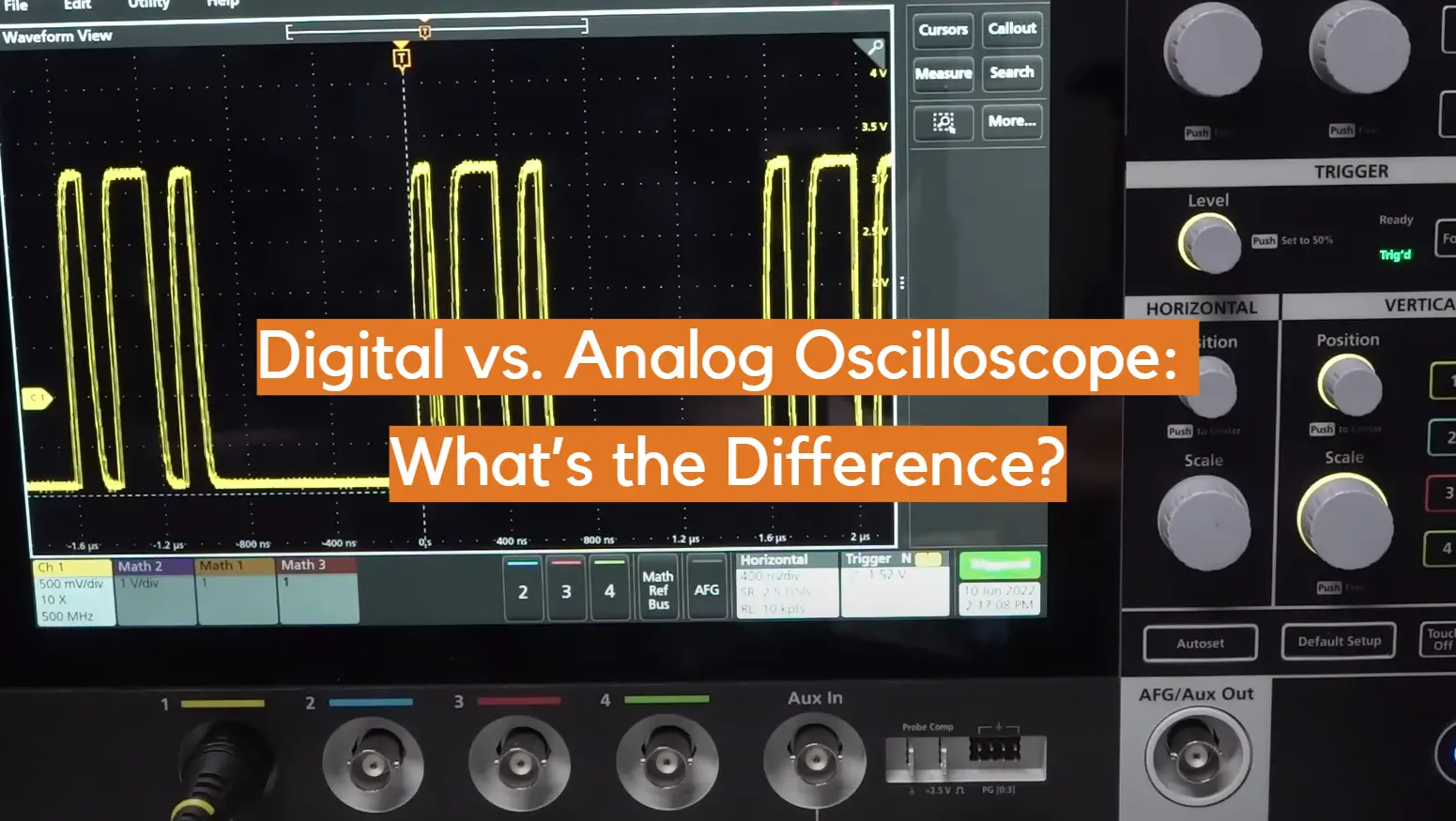





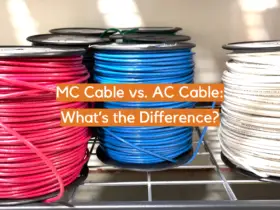


Leave a Reply